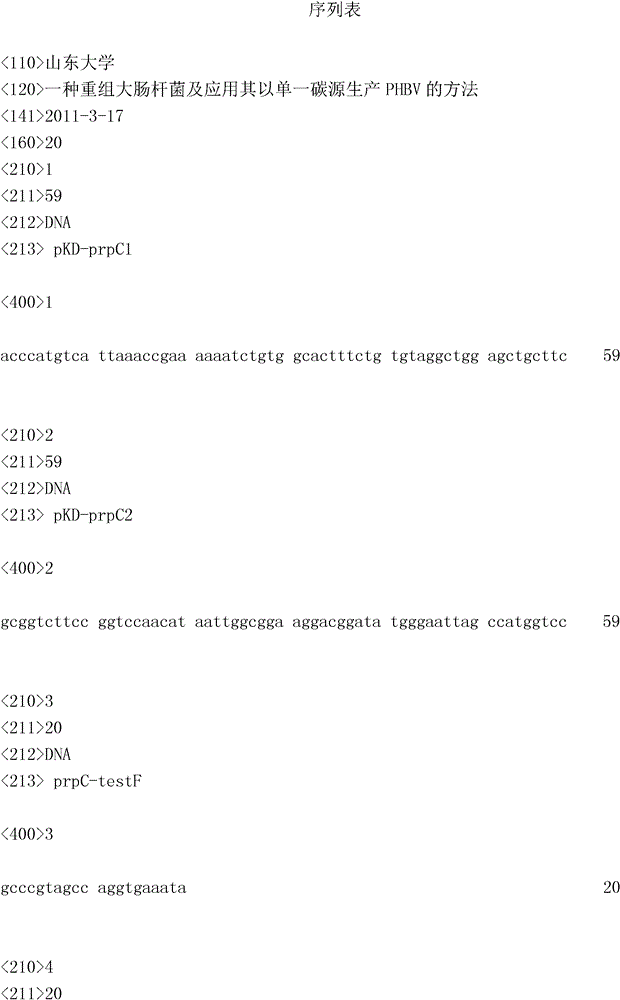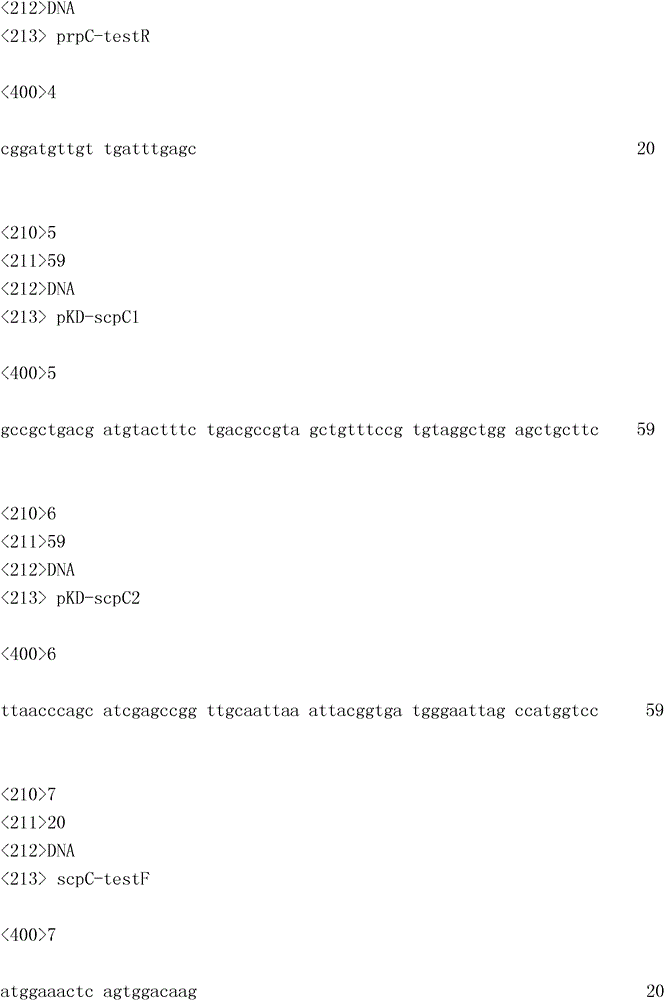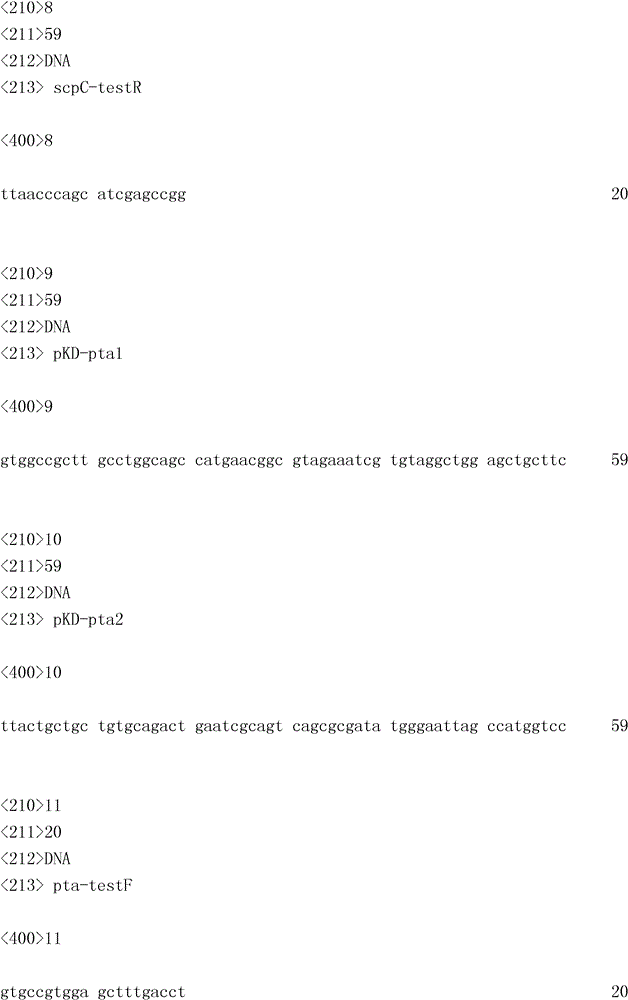Recombinant escherichia coli and method for applying same to produce poly(3-hydroxybutyrate-3-hydroxyvalerate) (PHBV) by utilizing single carbon source
A technology for recombining Escherichia coli and Escherichia coli, which is applied in the field of genetic engineering and microbial fermentation, can solve the problems of complex control strategies and high cost of PHBV
- Summary
- Abstract
- Description
- Claims
- Application Information
AI Technical Summary
Problems solved by technology
Method used
Image
Examples
Embodiment 1
[0030] Example 1. Strain Construction
[0031] (a). Knockout of prpC gene:
[0032] 1) Preparation of Escherichia coli DH5α Competent Cells
[0033] ①Pick a single colony of Escherichia coli and inoculate it in an LB liquid test tube, and culture it with shaking at 37°C overnight. Then inoculate the overnight culture in 30 ml of fresh LB liquid medium according to 1% transfer amount (volume ratio), and culture with vigorous shaking at 37°C, about 2h to OD 600 0.4 to 0.5.
[0034] ②Centrifuge at 4,000 rpm for 10 minutes at 4°C to collect bacteria. followed by 10 mL of ice-cold 0.1 M CaCl 2 suspended bacteria.
[0035] ③Centrifuge at 4000 rpm for 10 minutes at 4°C to collect bacteria. followed by 10 mL of ice-cold 0.1 M CaCl 2 Suspend the bacteria and place on ice for 30 minutes.
[0036] ④ Centrifuge at 4000 rpm for 10 minutes at 4°C to collect bacteria. Add 1 mL of ice-cold 0.1 M CaCl 2 -Glycerol solution to suspend the bacteria.
[0037] ⑤ Dispense 100 microliters / ...
Embodiment 2
[0204] Example 2. Recombinant Escherichia coli QW103PT utilizes xylose fermentation to produce PHBV, wherein the total sugar concentration added is 5 g / L.
[0205] (1) Strain selection: Escherichia coli QW103PT;
[0206] (2) plate culture: the bacterial classification is inoculated on the solid LB medium plate that contains the agar that is 1.5% by mass percentage and adds the ampicillin that final concentration is 50 micrograms / ml and the spectinomycin of 25 micrograms / ml, Under the condition of 25 ℃, static culture for 8 hours;
[0207] (3) Seed culture: the bacterial strain cultivated in step (2), under sterile conditions, connect 1 to 2 loops to 20 ml with an inoculation loop and add ampicillin and 25 μg / ml final concentration of 50 μg / ml Spectinomycin LB liquid medium, under the condition of 25 ℃, 150 rpm shaking culture for 8 hours, to obtain the seed solution;
[0208] (4) Expansion culture: with the inoculum size of 5% volume ratio, inoculate the seed liquid in 200mL...
Embodiment 3
[0214] Example 3. Recombinant Escherichia coli QW103PT utilizes xylose fermentation to produce PHBV, wherein the total sugar concentration added is 20 g / L.
[0215] (1) Strain selection: Escherichia coli QW103PT;
[0216] (2) plate culture: the bacterial classification is inoculated on the solid LB medium plate that contains the agar that is 2.0% by mass percentage and adds the ampicillin that final concentration is 150 micrograms / ml and the spectinomycin of 75 micrograms / ml, Under the condition of 42°C, culture statically for 16 hours;
[0217] (3) Seed culture: the bacterial strain cultivated in step (2), under sterile conditions, connect 1 to 2 loops to 100 ml with an inoculation loop and add ampicillin and 75 μg / ml final concentration of 150 μg / ml Spectinomycin LB liquid medium, under the condition of 42 ℃, 250 rpm shaking culture for 16 hours, to obtain the seed solution;
[0218] (4) Expansion cultivation: with the inoculum size of 15% volume ratio, inoculate the seed ...
PUM
 Login to View More
Login to View More Abstract
Description
Claims
Application Information
 Login to View More
Login to View More - R&D
- Intellectual Property
- Life Sciences
- Materials
- Tech Scout
- Unparalleled Data Quality
- Higher Quality Content
- 60% Fewer Hallucinations
Browse by: Latest US Patents, China's latest patents, Technical Efficacy Thesaurus, Application Domain, Technology Topic, Popular Technical Reports.
© 2025 PatSnap. All rights reserved.Legal|Privacy policy|Modern Slavery Act Transparency Statement|Sitemap|About US| Contact US: help@patsnap.com



